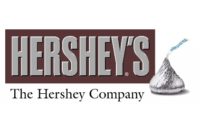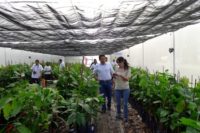
|
| A cocoa farmer sorts cocoa beans in West Africa. Photo provided by Hershey. |
Hershey may have been the last major chocolate makers to join the list of companies planning to use 100% sustainable cocoa by 2020 — following Mars, Nestle, Mondelez and Ferrero — but that doesn’t mean they aren’t taking the goal seriously.
“We have been looking at this for a long time,” says Andy McCormick, Hershey’s v.p. of public affairs. “We’re confident we will meet our target.”
In fact, the Hershey Co. has done a lot in the last 18 months to prove that and to become more socially responsible in general.
As a result, the Penn.-based chocolate marker has been recently recognized for its efforts, which include the following:
- Named to the Bloomberg Civic 50 as among the 50 most civic-minded companies
- Selected to Newsweek's 2012 Green Ranking, moving up 172 spots from last year
- Selected for the first time to the prestigious Dow Jones Sustainability Index and one of only seven North American companies for the Food & Beverage category.
- Invited to join the SASB advisory council to help develop sustainability reporting standards for the food and beverage industry
.
The recognition is great for a company that was the target of the “Raise the Bar, Hershey Coalition,” which attempted to highlight allegedly poor working conditions and child labor among cocoa farmers that supply Hershey.
However, in the past year and a half, the company has accelerated its sustainability programs, opened a new environmentally friendly plant, and done its best to get the word out about those efforts.
“We’re talking more about the work that we’re doing,” says Todd Camp, Hershey’s director of Corporate Social Responsibility (CSR).
One of Hershey’s sustainability efforts that will be expanding soon is CocoaLink, a program that sends information to cocoa farmers via text message. Started in Ghana in 2011, it now serves 10,000 cocoa farmers. McCormick says Hershey plans to roll out the program in the Ivory Coast next.
“The technology that’s sweeping through the area is really a way to get lots more information to lots more people,” he explains.
Hershey also joined the Advisory Council of the Sustainability Accounting Standards Board (SASB), which officially launched in October. The board’s goal is to create a uniform set of standards for individual industries that can then be used to easily compare sustainability efforts across various companies.
Camp says its needed because each industry has different issues it has to address when it comes to sustainability.
“This is essentially a group of a mix of academics and corporate world and some other non-profit organizations that develop a set of standards for reporting,” he explains. “SASA is really focused on industry, by industry developing a set of common standards. So for the confectionery industry, what are the core environmental issues to report? What are the core community relations issues to report?” Camp explains.
He compared it to the 10K report the financial industry developed two decades ago, which now every company does. The goal is to create a system that every candy company would participate it.
All the efforts in West Africa do have the potential to raise the price of a Hershey bar at the register, but Camp says the company’s efforts have built-in rewards. So, for example, Hershey’s work with cocoa farmers increase cocoa production by 30 to 50%, and environmental efforts have saved the company $20-$25 million over the last three years.
“If you look at the investments we’re making, those often times do produce cost savings for us, which allows us to invest in some of the other progressive programs,” Camp says. “And, they certainly do offer benefits in other ways. The work we’re doing is really part of the legacy and the foundation of our company.”
And that’s something even Milton Hershey would encourage.





